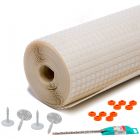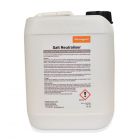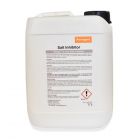Help & Advice Articles, Videos and How-to-Guides
Filter Articles

How to Stop Salt Coming Out of the Wall
No one likes seeing damp patches and white salt deposits in their home. They can look unsightly, damaging your walls while also signifying a wider issue. Luckily, salt on walls is a simple issue to sort, but you do need to deal with the source to prevent the deposits from returning. This does also mean stripping your walls right back, but don’t panic. We’re here to take you through the different types of salts and the best treatment methods in our guide.
What are the white marks on my wall?
If you’re seeing white stains or marks on your walls, then there’s a good chance they are salts coming through. Sometimes seen with tide marks or damp patches, salt deposits on walls can cause crumbling or bubbling paint or plaster, tarnishing any decorative finishes in your home.
There are several types of salt deposits, such as hygroscopic, deliquescence and efflorescence. It’s important to understand which you have so you can treat the issue effectively. To summarise the different types:
- Deliquescent salts - these salts dissolve when water from the atmosphere is absorbed. You may not physically see these types of salts as you’ll often see damp patches that render the salts invisible.
- Efflorescent salts - often visible on brickwork, they have a more crystalised appearance and a grainy or powdery texture. We’ll explore efflorescence later in our guide.
- Hygroscopic salts, which we’ll go into detail about below.
What are hygroscopic salts?
Hygroscopic salts are made up of nitrates (sodium) and chloride and can be seen on both internal and external walls. They’re soluble, sucking in the moisture from your home and forming white marks on your walls as this water evaporates. This water can be the result of damp issues caused by building faults or heavy rain, as a couple of examples.
Hygroscopic salts are similar to deliquescent deposits, but the salts remain ‘whole’ when water is absorbed, rather than turning into liquid. They can look slightly different throughout the day, depending on the amount of moisture they’re holding - especially if the moisture is forming tidemarks along the wall. Like deliquescent salts, you don’t often see hygroscopic salts and instead are more likely to see the tidemarks instead. This is where the salts hold onto the moisture, leaving dark, damp patches on your wall.
We’ve included images of hygroscopic salts below.
Hygroscopic salts examples

Bubbling paint due to salts |
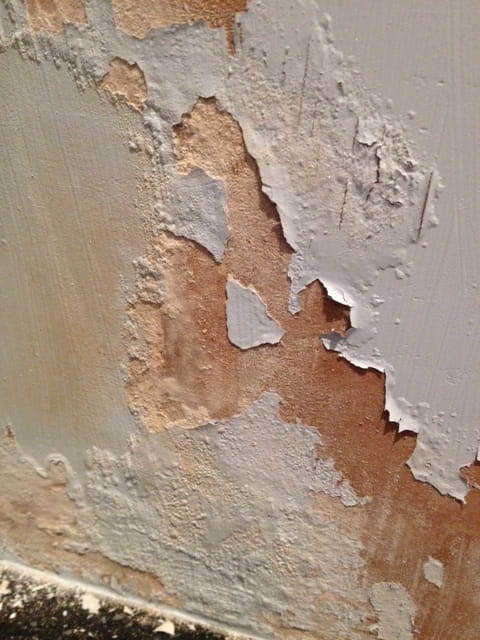
Peeling paint from salts |
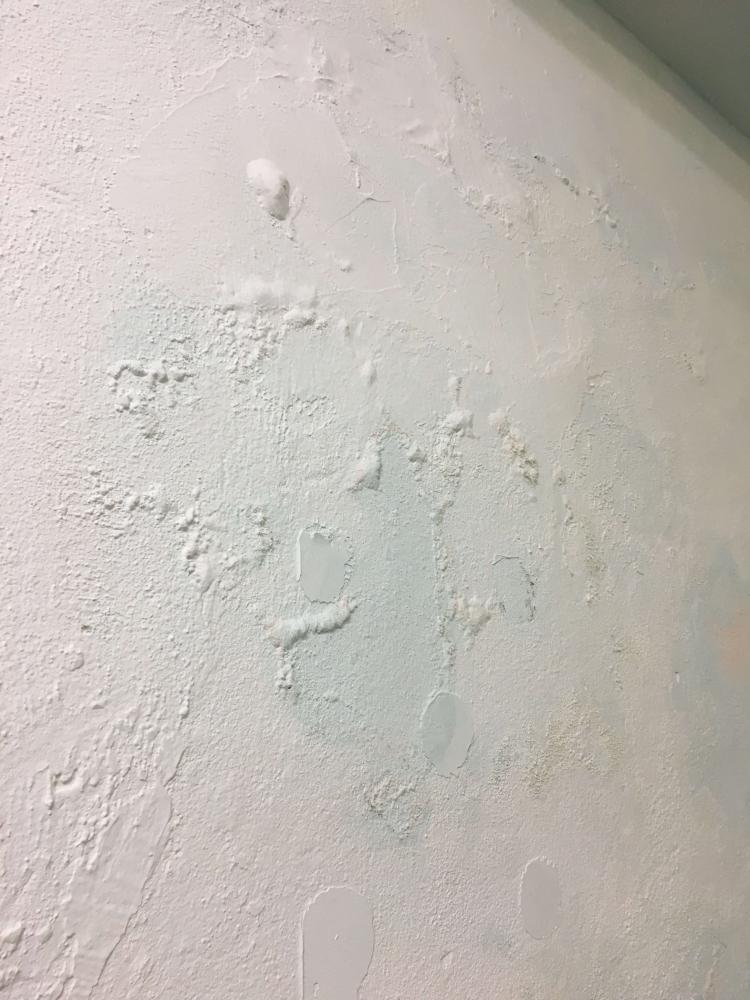
Paint affected by salts on the wall
What are efflorescent salts?
Efflorescence appears when water evaporates from the wall. They have a crystalised, chalky appearance and feel grainy to touch. Salt efflorescence on internal walls is made up of a mix of chemicals such as calcium carbonate, sodium and potassium.
Efflorescence on brick forms when water evaporates from the wall. They can occur either at construction of a building - due to them naturally occurring in some materials - or happen over time and are usually found on or near porous materials.
What causes salt on internal walls?
Salts appear when water in your home evaporates, leaving behind salt deposits on walls. They can occur naturally in some building materials, such as brickwork or lime, or are the result of a pre-existing issue, like damp. So, if you’re experiencing rising damp, salts appear when your walls start to dry out, leaving salts behind on the surface.
We go into more detail about damp issues that may cause salts below - click to read in depth guides on rising damp and penetrating damp.
Common causes of salts (and damp, in some cases) are:
- Using building materials with naturally occurring salts, such as bricks
- Heavy rain soaking into walls
- Groundwater entering the building, either through no or a damaged damp proof course (DPC), or when a DPC has been bridged.
- Water leaking into your building from pipes or another type of building fault
- Chimney breasts where fuel is burned, releasing chemicals that build up inside the chimney and form salts on the surface.
Certain types of salts can really exacerbate the issue of condensation. Condensation occurs when the atmosphere can’t hold any more moisture, so it condenses on cold surfaces. When the wall has hygroscopic salts present, the effect of condensation can look even worse as the high humidity levels give the salts plenty of moisture, encouraging even more severe looking damp patches. Read more about condensation here.
Should I worry about salts on walls?
In short, no. Salts themselves are not toxic or dangerous. They are more of a cosmetic issue, causing paint to crumble, damp patches and leaving white stains on a wall.
If the cause of your salts is damp, which is left untreated, then it could cause your building materials to decay and in turn lead to structural issues in your property. This is why you should always look past the salt coming through plaster and masonry and consider the wider problem, ensuring that it’s effectively dealt with to ensure your home is safe.
Identifying salt deposits on walls
To remove salts permanently, you first need to understand and identify the type. From here, you can then choose the best method of removal.
Generally, salt deposits on walls appear white and sometimes fluffy, and they may feel grainy to touch. However, for this step we recommend getting in touch with a professional who’ll provide you with a proper diagnosis. They can take samples and examine the salts while also confirming the cause.
You should keep in mind that the specific type of salts isn’t always clear, but identifying the cause will certainly help. Examples of this can be if there’s high use of materials with naturally occurring salts throughout your home or the salts are on or near a chimney breast.
How to stop salts coming out of the wall
Before putting protective measures in place, you’ll first need to fix the root cause of the salts in brickwork or plaster.
As mentioned earlier, salts can sometimes occur naturally in materials. In these instances, you should use a salt neutraliser first before going in with more invasive methods of removal. It is worth noting that, if you have a mass breakout, then neutralisers are not going to be effective, and you should try another treatment. Salt neutralisers are best for smaller, more localised salt patches.
Other causes of salts can include rising and penetrating damp, which needs to be sorted in a different way.
Salts from rising damp
If you’re seeing tidemarks on your wall, then you likely have rising damp. This occurs when a property has no DPC, or an existing one has been bridged or failed, allowing groundwater to rise through walls via capillary action.
As well as tidemarks up to 1.5 metres high, other signs of rising damp include:
- White salts on the surface
- Stained paint or plaster
- Paint bubbling or even peeling off all together
If left untreated, rising damp can lead to structural issues. This is why you should speak with a professional to confirm the source of the damp before treatment.
To stop rising damp, you can install a new DPC using a damp proofing cream, such as PermaSEAL PRO DPC Injection Cream. The PermaSEAL PRO Cream, also available as a 10 cartridge PermaSEAL PRO DPC Injection Kit, is an effective way of treating rising damp - simply inject it into drilled holes on your external wall. The product will then line the capillaries of the brickwork with its active ingredients - such as silane - forming a permanent barrier that will keep you protected for good.
Learn more about treating rising damp.
Salts from penetrating damp
Salts can enter your home when water seeps in from outside, causing penetrating damp. This can be caused by heavy rain soaking into brickwork, failed render, leaky pipes or a wall crack allowing rainwater in. To identify penetrating damp, look for wet patches on walls or stains on plaster.
If a crack or leaky pipe are the cause, then these need to be fixed to then deal with the salts left behind. If the damp is the result of heavy rain, then you need to use a water repellent on your masonry.
PermaSEAL Facade Cream soaks into the exterior of your walls, lining the pores of the brickwork. This creates a breathable barrier that protects your home from damp, and your brickwork from water damage and freeze thaw. The product has a cream consistency that doesn’t run down your walls and stays in contact with the masonry for longer, allowing for the slow absorption to ensure deeper penetration. You only need one coat, and the barrier lasts for 20+ years.
See our PermaSEAL Facade Cream here, or read more about preventing penetrating damp with water repellents.
How to treat hygroscopic salts
So, you’ve identified the cause and sorted the issue - now to deal with the salts themselves.
For this you’ll need to fully strip back the wall to the brickwork to properly treat salts on internal walls, depending on the extent of the damage. While this may seem excessive, it is the only way to fully remove the salts and prevent them from coming back. Once a surface is affected, the salts will always remain.
Having said that, in the case of hygroscopic salts - where the humidity and amount of moisture in the atmosphere has a direct bearing on the issue becoming visible -, controlling the humidity with the correct ventilation and heating can sometimes solve the problem without the need for more invasive action.
Render systems to remove salt on brickwork
There are two ways to re-render after sorting a damp issue. You want to choose the method that works best for you and your scenario.
The first method is using plaster products such as Limelite, who provide breathable renovating plaster solutions that dry fast and leave durable finishes.
For this system you need to:
- Prime the wall with Limelite Easy-Bond Primer
- Render over this with two coats of Limelite Renovating Plaster
- Finally, skim the surface with Limelite High Impact Finishing Plaster
The other render system is a more traditional, tried-and-tested method:
- First prime the wall with Permagard Salt Inhibitor.
- Next, render the wall with a mix of three parts of washed sharp sand to one part of cement, gauged with clean water, which should contain one part of PermaProof Waterproofer per 24 parts of water.
- Apply a second coat of the mixture to the wall once the first coat is dry.
- Skim with a multi finish plaster to finish.
It’s worth noting that this method can take longer than using Limelite products, but does provide a strong barrier against salts. Learn more about re-rendering after installing a new DPC.
Note: there is always the risk of aggressive salts transferring through the render system during the wet phase, so it’s important to follow the guidelines around render coat thicknesses and drying times between coats to stop this from occurring.
Treating salts with a damp proof membrane
Damp proof membranes are a quick and easy way to protect against salts as well as damp. If you have a wall that’s been affected by salts, a membrane will isolate this wall from new finishes and prevent the reappearance of salt on internal walls.
You can install our PermaSEAL 3 Damp Proof Membrane immediately after applying a new DPC.
- Clean the wall of debris and ensure the surface is as flat as possible.
- Cut the damp proof membrane to size - this can be done with scissors or a sharp knife.
- Fix the membrane to a surface with plugs - make sure that the mesh is facing outwards when doing this. The membrane can be fixed horizontally or vertically, and you can render or dot and dab straight after installation.
When properly installed, the membrane acts as an impermeable barrier between the contaminated wall and new plaster or decoration, providing protection for years to come.
Hygroscopic salts in chimney breast
One common area affected when it comes to salts in brickwork is chimney breasts. This is often the result of burning fuels such as coal or wood, allowing the salts in your chimney to accumulate overtime.
Penetrating damp can also cause salts in your chimney. Look for the signs mentioned earlier in this article to diagnose the cause and treat effectively.
Once the cause is dealt with, you can then isolate or remove the salts by using one of the methods we’ve listed above:
For more guidance on dealing with hygroscopic salt chimney damp click here.
Treating salts with Permagard
Salts are not something to stress about, but you need to make sure the root cause is sorted and all salts are removed for a permanent solution. If you need help dealing with the issue, get in touch with our technical team by calling 0117 982 3282 or sending an email to [email protected].

